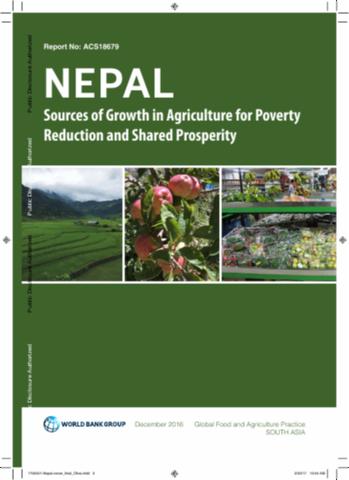Resource information
Agriculture contributes about 35 percent to the Gross Domestic Product (GDP) of Nepal. But growth in the sector has been quite volatile in the last decade, tothe extent that the lowest and highest growth rates were recorded in consecutive years. Nepal agriculture is characterized by relatively low yields compared to neighboring countries. Furthermore,land is disproportionately allocated to grain staples (rice, maize, wheat, millet, barley, and buckwheat),despite fruits and vegetables showing relatively higher yields and higher growth in consumption. A proper understanding of the sources of agriculture growth would help identify what kind of agriculture offers most potential to further reduce poverty and boost shared prosperity.Nepal is increasingly becoming a net importer of food, both in high value foods such asfruits and vegetables as well as staples such as rice, potatoes, and maize. Expanding exports would require investments in infrastructure and a conducive regulatory environment to certify that products from Nepal achieve the various Sanitary and Phyto-sanitary standards of foreign markets. The main objective of this report is to identify policy and investment priorities to stimulate agricultural growth for poverty reduction and shared prosperity. The study ultimately seeks to inform strategic dialogue between Government of Nepal and the World Bank Group towards investments inagriculture and supporting sectors. The report provides building blocks to identify policy andinvestments priorities. After a brief Introduction, Chapter 2 examines the main drivers of agriculturefor poverty reduction and shared prosperity. The key issues addressed are drivers of agricultural income, drivers of total factor productivity growth, emerging patterns of diversification, degree of mechanization, and constraints to investments in the sector. Chapter 3 examines the effects of public expenditures in fertilizer and seed distribution programs, paying specific attention to effects on: supply of fertilizers, fertilizer application rates, retail prices, private sector participation, performance of the distribution chain, relative access between various categories of farmers, and consistency of the program with inequalities in the distribution of poverty and food and nutritional security. Chapter 4 generates lessons on policy and investments to expand exports. Chapter 5 generates lessons on policy and investments to substitute imports. Chapter 6 provides overall recommendations for policy and investments priorities, while distinguishing between actions needed to stimulate broad-based productivity growth with actions need for export promotion and import substitution.


